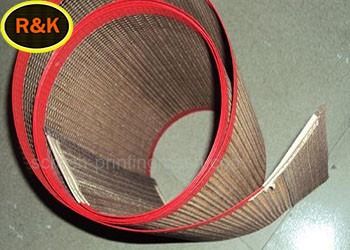Good feedback Conveyor Belts mesh conveyor belt
Conveyor Belts characteristics
1). High temperature resistance--It can continuously work under-140 to 260, max resist high temperature up to 360.
2). Chemical resistance--It can resist all most of chemical medicines.
3). Permeability--It can avoid wasting heat and improve drying efficiency for it's permeability.
4). Non Stick--It can easily remove all kinds of adhesives such as resin, paint and chemical medicine, easy to clean.
5). Stable dimension, high intensity, elongation coefficient less 5%.
6). Low coefficient of friction and dielectric constant, good insulting ability.
7). Good flex fatigue resistance--It has high tensile strength and excellent flex fatigue resistance. It's better for small wheels.
8). Resistance to UV, IR and HF; Non-toxic, 100%PFOA free.
About Conveyor Belts conveyor belt
PTFE() meshbelt select fine fiberglass, Kevlar or Nomex as basic weaving material, coated with excellent PTFE() resin to make it into various of PTFE() mesh conveyor belt.
Conveyor Belts Application
There are a number of factors to keep in mind when choosing the belting material for your application:
Temperature Range – Our ptfe fabrics have the capabilities of withstanding -70°C- +260°C constant operating temperatures.
Pliability – If the material is to track around pulleys that drive the belt, the diameter of the pulley is critical. The smaller the roller the more flexible the belt must be. Ruida’s thinner materials (0.010” and under) are more pliant than the heavier coated fabrics.
Release Qualities – The surface finishes of our materials range from a rough, semi-porous finish to a super smooth surface. The release or fabric impression results desired will be a determining factor.
Strength – Options to be considered are breaking, tensile and tear strength. How much of a load the belt carries, how fast it moves and how tightly it will be tensioned all must be considered.
Conveyor Belts Introduction
Commonly used lap (not removable), butt (up and down lap cloth), cow nose joint (easy to disassemble), steel button joint
(inconvenient to disassemble, etc.)
Company Profile:
Founded in 1997. It has a history of more than 20 years. Our customers come from more than 60 countries. We provide customers with professional services and the best quality products. Our main products: polyester/nylon/stainless steel screen printing mesh, polyester/nylon/stainless steel filter screen, screen filter Ware, polyester mesh belt and metal mesh belt.
Our company is located in Shijiazhuang, and the factory is located in the southern industrial park of Anping County, the famous hometown of wire mesh in China.
| Name |
High density polyethylene fiber glass mesh fabric conveyor belt |
| Material |
Fiberglass coated with PTFE |
| Mini order quantity |
1pc |
| Color |
Black, brown, |
| Thickness |
0.5mm 0.7mm 1mm 1.2mm;can be customized |
| Mesh size |
1x1mm, 2x2mm, 4x4mm /Customized |
| Max Width |
4100mm |
| Temperature resistance |
-70℃~ 260℃ |
| Certificate |
FDA/SGS/PONY/ROHS/REACH/LFGB, |
| Features |
Non stick, 100%PFOA free, washable, heat-resistant, eco-friendly,Chemical resistance, air permeability |


 Your message must be between 20-3,000 characters!
Your message must be between 20-3,000 characters! Please check your E-mail!
Please check your E-mail!  Your message must be between 20-3,000 characters!
Your message must be between 20-3,000 characters! Please check your E-mail!
Please check your E-mail! 




